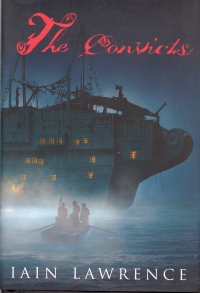| ________________
CM . . .
. Volume XII Number 13 . . . .March 3, 2006
excerpt:
Fourteen-year-old Tom Tin and his family are on the run from London, attempting to evade the villainous Mr. Goodfellow, whose mission is to destroy the Tins. After Goodfellow succeeds in dragging Mr. Tin to debtors’ prison, Tom runs away from home in order to settle his father’s accounts. Although he thinks his troubles are over when he accidentally discovers a diamond, his fate turns as he becomes caught in a case of mistaken identity: he stands trial for murder and is consequently set on a ship bound for Van Diemen’s Land. Tom and his new friend, Midgeley, attempt to escape; however, they are caught and transferred to a converted slaver ship headed for an uncertain future amid hundreds of dangerous fellow convicts. The Convicts, set primarily in nineteenth century London, is an old-fashioned historical adventure tale. From the first pages, Lawrence writes in the tradition of Victorian novelists, as Tom’s mother declares in typical Dickensian fashion, “I never should have married a sailor, and I won’t have one for a son. You’re to be a gentleman, Tom.” Hints of other Victorian novels, such as Oliver Twist, Jekyll and Hyde, and Dracula, appear throughout The Convicts, as Lawrence weaves the typical Victorian themes of identity and poverty into his work. The novels contains compelling descriptions of the setting. The city of London, for instance, acts as a character, with its labyrinthine streets and its babble of noises. As well, the London fog, so prevalent in Victorian literature, is featured in its layers of monstrosity: it rolls over the scenery, filling the city streets, and envelopes everything in its path. Tom, as he coughs while running away from home, even compares his phlegm to the thick yellow fog. Tom Tin is a cross between Oliver Twist’s Oliver and the Artful Dodger: he longs to be a good person, though his bad streak becomes prominent. At first, Tom is selfish and lacks courage; for example, he intends to leave Midge behind when they escape the ship: “I would leave him sleeping in the rushes like the baby Moses in his Bible book.” However, his character develops throughout the novel’s 198 pages as his nastiness is tempered by Midge who encourages him see the world with a fresh perspective. Toward the end of the adventure, Tom begins to develop a sense of valor; for instance, he decides to begin praying for courage, instead of deliverance, as he seeks to understand why his personality appears to have been split in the middle. The novel, however, is not for the fainthearted reader. Many of its scenes are grotesque: “I straddled the dead boy, my feet in his coffin, and scooped my hands below his shoulders. I pulled, and up he say, his head nodding forward, his mouth gaping open.” The Convicts features many scenes of astonishing violence; for example, Tom discovers that Midgeley’s eyes have been punctured by their nemesis, Benjamin Penny. However, the novel’s violence is necessary for the plot development; as well, it certainly maintains the reader’’s interest. The Convicts may not appeal to reluctant readers because of its numerous references to Victorian vernacular, such as ha’’penny, curricle, and parish Charlie. However, this novel is recommended for avid fans of historical fiction. Recommended. Pam Klassen-Dueck obtained her Bachelor of Arts and Bachelor of Education degrees at the University of Manitoba. She has taught Grade 8 and Grade 11 English. Currently, she is enrolled in the pre-M.A. program at the U of M.
To comment
on this title or this review, send mail to cm@umanitoba.ca.
Copyright © the Manitoba Library Association. Reproduction for personal
use is permitted only if this copyright notice is maintained. Any
other reproduction is prohibited without permission.
NEXT REVIEW |
TABLE OF CONTENTS FOR THIS ISSUE
- March 3, 2006.
AUTHORS |
TITLES |
MEDIA REVIEWS |
PROFILES |
BACK ISSUES |
SEARCH |
CMARCHIVE |
HOME |
